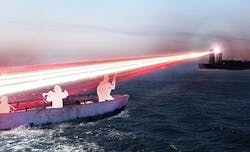DARPA seeks to develop non-lethal weapons and sensors that pop up from the ocean's depths
ARLINGTON, Va., 15 Jan. 2013. Imagine a bunch of distracting laser strobes, electronic warfare jammers, or other kinds of non-lethal weapons that pop up seemingly up without warning from the ocean's depths in the middle of one of the world's naval battle groups.
That's just what scientists at the U.S. Defense Advanced Research Projects Agency (DARPA) envision from the upcoming Upward Falling Payloads (UFP) program, which seeks to pre-deploy sensors or non-lethal weapons on the ocean floor sometimes years in advance for surprise deployment among the nation's naval adversaries during times of war or international tension.
DARPA on Friday issued a broad agency announcement (DARPA-BAA-13-17) for the UFP program, which seeks to design non-lethal weapons or situational-awareness sensors that can be placed on the ocean floor, with propellant to launch payloads to the ocean surface, and communications systems that enable their deployment at standoff ranges.
DARPA to brief industry on Upward Falling Payloads (UFP) program 25 Jan. in Arlington, Va.
The primary reason for the UFP program is the high cost and logistical difficulty of deploying many Navy ships and weapons in forward operating areas of vast global ocean areas. Instead, DARPA wants upward falling unattended sensor or non-lethal weapon payloads pre-deployed for use at a moment's notice.
Concealment of the sea provides the opportunity to surprise maritime targets from below, as well as the ability to operate across great distances, DARPA researchers say. Getting close to targets without warning, and deploying systems without delay are key attributes of anticipated UFP capability.
To succeed, the UFP program must be able to demonstrate a system that can survive for years under extreme pressure; be triggered from standoff commands; and rapidly rise through the water and deploy a non-lethal weapon or sensor payload.
The UFP system is envisioned to consist of three key subsystems: the payload, which carries out ocean or air applications after deployment; the UFP riser, which launches the payload from the ocean floor to ocean's surface; and the UFP communications that triggers the UFP riser to launch.
The first phase of the UFP program should lead to conceptual designs and feasibility assessments. UFP communications will be key. The second phase will develop major UFP subsystems, and demonstrate a UFP riser and communications. The third phase will integrate UFP communications and UFP subsystems to full depth and communications capability.
The UFP program's second phase should develop subsystems at a technology readiness levels (TRL) of four to five. the third phase should develop subsystems at TRL six.
Companies interested should send abstracts no later than 5 Feb. 2013 to DARPA/STO, 675 North Randolph Street, Arlington, VA 22203-2114 (Attn.: BAA 13-17). Full proposals are due to the same address no later than 12 March 2013.
E-mail questions or concerns to DARPA at [email protected].
More information is online at https://www.fbo.gov/spg/ODA/DARPA/CMO/DARPA-BAA-13-17/listing.html.

John Keller | Editor
John Keller is editor-in-chief of Military & Aerospace Electronics magazine, which provides extensive coverage and analysis of enabling electronic and optoelectronic technologies in military, space, and commercial aviation applications. A member of the Military & Aerospace Electronics staff since the magazine's founding in 1989, Mr. Keller took over as chief editor in 1995.



